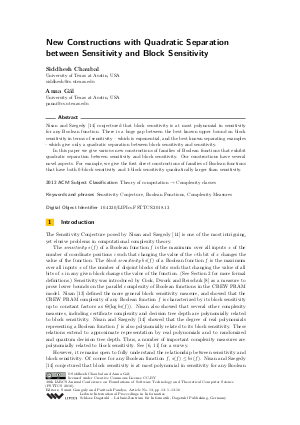New Constructions with Quadratic Separation between Sensitivity and Block Sensitivity
Authors Siddhesh Chaubal, Anna Gál
-
Part of:
Volume:
38th IARCS Annual Conference on Foundations of Software Technology and Theoretical Computer Science (FSTTCS 2018)
Part of: Series: Leibniz International Proceedings in Informatics (LIPIcs)
Part of: Conference: IARCS Annual Conference on Foundations of Software Technology and Theoretical Computer Science (FSTTCS) - License:
 Creative Commons Attribution 3.0 Unported license
Creative Commons Attribution 3.0 Unported license
- Publication Date: 2018-12-05
File

PDF
LIPIcs.FSTTCS.2018.13.pdf
- Filesize: 439 kB
- 16 pages
Document Identifiers
Subject Classification
ACM Subject Classification
- Theory of computation → Complexity classes
Keywords
- Sensitivity Conjecture
- Boolean Functions
- Complexity Measures
Metrics
- Access Statistics
-
Total Accesses (updated on a weekly basis)
0Document
0Metadata
Abstract
Nisan and Szegedy [Nisan and Szegedy, 1994] conjectured that block sensitivity is at most polynomial in sensitivity for any Boolean function. There is a huge gap between the best known upper bound on block sensitivity in terms of sensitivity - which is exponential, and the best known separating examples - which give only a quadratic separation between block sensitivity and sensitivity. In this paper we give various new constructions of families of Boolean functions that exhibit quadratic separation between sensitivity and block sensitivity. Our constructions have several novel aspects. For example, we give the first direct constructions of families of Boolean functions that have both 0-block sensitivity and 1-block sensitivity quadratically larger than sensitivity.
Cite As Get BibTex
Siddhesh Chaubal and Anna Gál. New Constructions with Quadratic Separation between Sensitivity and Block Sensitivity. In 38th IARCS Annual Conference on Foundations of Software Technology and Theoretical Computer Science (FSTTCS 2018). Leibniz International Proceedings in Informatics (LIPIcs), Volume 122, pp. 13:1-13:16, Schloss Dagstuhl – Leibniz-Zentrum für Informatik (2018)
https://doi.org/10.4230/LIPIcs.FSTTCS.2018.13
BibTex
@InProceedings{chaubal_et_al:LIPIcs.FSTTCS.2018.13,
author = {Chaubal, Siddhesh and G\'{a}l, Anna},
title = {{New Constructions with Quadratic Separation between Sensitivity and Block Sensitivity}},
booktitle = {38th IARCS Annual Conference on Foundations of Software Technology and Theoretical Computer Science (FSTTCS 2018)},
pages = {13:1--13:16},
series = {Leibniz International Proceedings in Informatics (LIPIcs)},
ISBN = {978-3-95977-093-4},
ISSN = {1868-8969},
year = {2018},
volume = {122},
editor = {Ganguly, Sumit and Pandya, Paritosh},
publisher = {Schloss Dagstuhl -- Leibniz-Zentrum f{\"u}r Informatik},
address = {Dagstuhl, Germany},
URL = {https://drops.dagstuhl.de/entities/document/10.4230/LIPIcs.FSTTCS.2018.13},
URN = {urn:nbn:de:0030-drops-99129},
doi = {10.4230/LIPIcs.FSTTCS.2018.13},
annote = {Keywords: Sensitivity Conjecture, Boolean Functions, Complexity Measures}
}
Author Details
References
- Andris Ambainis. Polynomial degree vs. quantum query complexity. J. Comput. Syst. Sci., 72(2):220-238, 2006. URL: http://dx.doi.org/10.1016/j.jcss.2005.06.006.
- Andris Ambainis, Mohammad Bavarian, Yihan Gao, Jieming Mao, Xiaoming Sun, and Song Zuo. Tighter Relations between Sensitivity and Other Complexity Measures. In Automata, Languages, and Programming - 41st International Colloquium, ICALP 2014, Copenhagen, Denmark, July 8-11, 2014, Proceedings, Part I, pages 101-113, 2014. URL: http://dx.doi.org/10.1007/978-3-662-43948-7_9.
- Andris Ambainis and Krisjanis Prusis. A Tight Lower Bound on Certificate Complexity in Terms of Block Sensitivity and Sensitivity. In Mathematical Foundations of Computer Science 2014 - 39th International Symposium, MFCS 2014, Budapest, Hungary, August 25-29, 2014. Proceedings, Part II, pages 33-44, 2014. URL: http://dx.doi.org/10.1007/978-3-662-44465-8_4.
- Andris Ambainis, Krišjānis Prūsis, and Jevgēnijs Vihrovs. Sensitivity Versus Certificate Complexity of Boolean Functions. In Computer Science - Theory and Applications, pages 16-28, Cham, 2016. URL: http://dx.doi.org/10.1007/978-3-319-34171-2_2.
- Andris Ambainis and Xiaoming Sun. New separation between s(f) and bs(f). Electronic Colloquium on Computational Complexity (ECCC), 18:116, 2011. URL: http://eccc.hpi-web.de/report/2011/116.
- Harry Buhrman and Ronald De Wolf. Complexity measures and decision tree complexity: a survey. Theoretical Computer Science, 288(1):21-43, 2002. URL: http://dx.doi.org/10.1016/S0304-3975(01)00144-X.
- Sourav Chakraborty. On the Sensitivity of Cyclically-Invariant Boolean Functions. CoRR, abs/cs/0501026, 2005. URL: http://arxiv.org/abs/cs/0501026,
- Stephen A. Cook, Cynthia Dwork, and Rüdiger Reischuk. Upper and Lower Time Bounds for Parallel Random Access Machines without Simultaneous Writes. SIAM J. Comput., 15(1):87-97, 1986. URL: http://dx.doi.org/10.1137/0215006.
- Justin Gilmer, Michael Saks, and Srikanth Srinivasan. Composition limits and separating examples for some boolean function complexity measures. Combinatorica, 36(3):265-311, June 2016. URL: http://dx.doi.org/10.1007/s00493-014-3189-x.
- Parikshit Gopalan, Rocco A. Servedio, Avishay Tal, and Avi Wigderson. Degree and Sensitivity: tails of two distributions. CoRR, abs/1604.07432, 2016. URL: http://arxiv.org/abs/1604.07432.
- Pooya Hatami, Raghav Kulkarni, and Denis Pankratov. Variations on the Sensitivity Conjecture. Theory of Computing, Graduate Surveys, 4:1-27, 2011. URL: http://dx.doi.org/10.4086/toc.gs.2011.004.
- Claire Kenyon and Samuel Kutin. Sensitivity, Block Sensitivity, and L-block Sensitivity of Boolean Functions. Inf. Comput., 189(1):43-53, February 2004. URL: http://dx.doi.org/10.1016/j.ic.2002.12.001.
- Noam Nisan. CREW PRAMs and decision trees. SIAM J. Comput., 20(6):999-1007, 1991. URL: http://dx.doi.org/10.1137/0220062.
- Noam Nisan and Mario Szegedy. On the degree of boolean functions as real polynomials. Computational Complexity, 4(4):301-313, December 1994. URL: http://dx.doi.org/10.1007/BF01263419.
- David Rubinstein. Sensitivity vs. block sensitivity of Boolean functions. Combinatorica, 15(2):297-299, June 1995. URL: http://dx.doi.org/10.1007/BF01200762.
- Hans-Ulrich Simon. A tight ω(loglog n)-bound on the time for parallel RAM’s to compute nondegenerated boolean functions. Information and Control, 55(1):102-107, 1982. URL: http://dx.doi.org/10.1016/S0019-9958(82)90477-6.
- Avishay Tal. Properties and applications of boolean function composition. In Innovations in Theoretical Computer Science, ITCS '13, Berkeley, CA, USA, January 9-12, 2013, pages 441-454, 2013. URL: http://dx.doi.org/10.1145/2422436.2422485.
-
Avishay Tal. Personal communication, 2018.

- Madars Virza. Sensitivity versus block sensitivity of Boolean functions. Information Processing Letters, 111(9):433-435, 2011. URL: http://dx.doi.org/10.1016/j.ipl.2011.02.001.
